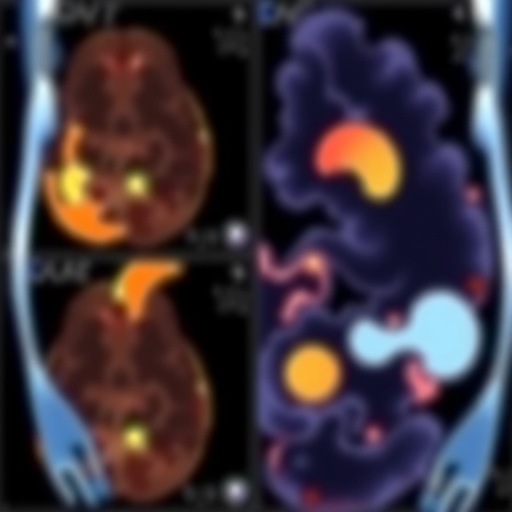In a groundbreaking revelation poised to reshape our understanding of neuropsychiatric disorders, researchers at Fujita Health University and the Tokyo Metropolitan Institute of Medical Science have unveiled a novel brain abnormality termed “hyper-maturity” in the hippocampus. This condition, characterized by excessive maturation and accelerated aging of hippocampal cells, offers new insights into anxious behavior and its underlying molecular mechanisms. Published recently in Neuropsychopharmacology, this comprehensive study scrutinized extensive omics datasets from multiple mouse models, revealing a consistent gene expression signature that challenges previous paradigms focused predominately on neuronal immaturity.
Traditionally, neuropsychiatric disorders have been linked with immature neuronal states—an idea that has shaped decades of research. However, the Fujita team’s systematic meta-analysis spanning 17 datasets and 16 mouse models, which included conditions like anxiety, depression, schizophrenia, and neurodegeneration, explains a more nuanced picture. Some models manifest not immature but excessively advanced developmental and aging gene profiles in the hippocampus. This duality of maturation—either under-development or over-development—adds an unexpected layer of complexity to the biological basis of these disorders.
Central to this hyper-maturity phenomenon are alterations in synaptic pathways. These synaptic processes are crucial for hippocampal function, a brain region intimately involved in memory and emotional regulation. The study pinpointed consistent upregulation of hallmark synaptic genes such as Camk2a and Grin2b across various hyper-mature models, suggesting synaptic remodeling and plasticity are driving forces behind this accelerated aging phenotype. Such upregulation contrasts with the expression patterns seen in models exhibiting neuronal immaturity.
To quantify the degree of cellular maturity within the hippocampus, the researchers introduced a novel “maturity index” derived from gene expression data. Strikingly, this quantitative measure revealed that models exhibiting hippocampal hyper-maturity correlated with higher levels of anxiety-like behavior. This contrasts with immature hippocampal states, which appear to be linked with reduced anxiety manifestations. The data also showed that prolonged exposure to corticosterone—a stress hormone integral to the hypothalamic-pituitary-adrenal (HPA) axis—induces similar hyper-mature gene expression and anxiety behaviors in mice, reinforcing the connection between chronic stress, brain aging, and emotional dysregulation.
Postnatal brain development and biological aging are interconnected, continuous processes rather than discrete events. By comparing gene expression trajectories in the hyper-mature mice, researchers discerned two distinct clusters: those exhibiting enhanced postnatal developmental gene expression akin to rapid maturation; and others demonstrating gene profiles typical of accelerated aging. For example, serotonin transporter knockout mice exemplify enhanced postnatal development, while corticosterone-treated and lysosomal storage disorder models exemplify accelerated hippocampal aging. This stratification hints at diverse pathological pathways converging on similar behavioral phenotypes.
Interestingly, cell-type specific analyses implicated non-neuronal cells such as microglia and astrocytes, alongside granule neurons, as contributors to these aging-like gene expression shifts. Given astrocytes’ roles in neurotransmitter regulation and microglia’s function in neuroinflammation and synaptic pruning, their involvement suggests hyper-maturity may result from complex intercellular dynamics rather than solely neuronal alterations. This multidimensional cellular interplay may inform future strategies for mitigating pathological brain aging.
Translationally, this new understanding has profound implications for human neuropsychiatric disorders. By analyzing hippocampal transcriptomes from postmortem brains of patients with depression, bipolar disorder, and schizophrenia, the researchers observed overlapping gene expression patterns indicative of hyper-maturity and accelerated aging. Despite heterogeneity across human samples, these findings align with emerging literature documenting stress-induced biological aging in the brain, thus reinforcing a shared molecular framework across psychiatric conditions.
The discovery of a hyper-maturity signature also raises the possibility of identifying transdiagnostic biomarkers that transcend traditional diagnostic categories. Genes persistently dysregulated in this hyper-mature state could serve as targets for innovative therapeutics that modulate brain maturation and aging processes. This shift from purely symptomatic treatments towards underlying molecular interventions could revolutionize psychiatric care, particularly for anxiety-related disorders.
Yet, critical questions remain unresolved. The precise molecular cascades linking diverse genetic and environmental risk factors to hyper-maturity are not fully elucidated. Brain maturation and aging are not passive or linear; they are actively influenced by factors such as neuronal activity, stress responses, and inflammatory states. Deciphering how these elements orchestrate hyper-maturation is essential for devising targeted modulation strategies.
Looking forward, the prospect of “brain rejuvenation” therapies emerges—interventions that could potentially reverse or recalibrate aberrant maturation trajectories. Such therapies might not only ameliorate psychiatric symptoms but also delay or counteract cognitive decline associated with aging. This concept bridges psychiatric research and anti-aging neuroscience, suggesting that nuanced regulation of neuronal maturation dynamics could become a focal point in future brain health paradigms.
The Fujita team’s study expands the neuropsychiatric research horizon by highlighting the plasticity and dynamism of hippocampal development beyond classical parameters of neurodegeneration or impaired neurogenesis. By mapping the full spectrum of maturation abnormalities—from immaturity to hyper-maturity—this research underscores the complexity of brain aging and emotional behavior regulation.
Ultimately, these revelations affirm that understanding the hippocampus as a highly malleable system responsive to both intrinsic genetic programs and extrinsic environmental factors is crucial for addressing anxiety and related disorders. As the field advances, integrating multi-omics data with behavioral phenotyping could unlock new doors to precision medicine solutions.
In conclusion, the identification of hippocampal hyper-maturity as a key player in anxiety-like behaviors and accelerated aging represents a paradigm shift in neuropsychiatric research. It challenges established dogma, offering fresh insights shared across psychiatric illnesses and pointing towards future molecular targets. The potential to modulate brain maturation and aging trajectories may inaugurate a new era in the prevention and treatment of mental health disorders.
Subject of Research: Animals
Article Title: Hyper-maturity and accelerated aging in the hippocampus of mouse models of neuropsychiatric disorders with anxiety-like behavior
News Publication Date: October 27, 2025
References: DOI: 10.1038/s41386-025-02237-6
Image Credits: Dr. Hideo Hagihara from Fujita Health University, Japan
Keywords: hippocampus, hyper-maturity, accelerated aging, anxiety-like behavior, neuropsychiatric disorders, synaptic gene expression, corticosterone, stress, neuronal plasticity, postnatal development, microglia, astrocytes, brain rejuvenation
Tags: comprehensive study on brain abnormalitiesduality of neuronal developmentemotional regulation and memorygene expression in anxietyhippocampal synaptic pathwayshyper-maturity in hippocampusmolecular mechanisms of anxietymouse models in neuroscienceneurodegeneration and brain agingneuropsychiatric disorders researchomics datasets in psychiatryrapid aging of brain cells




